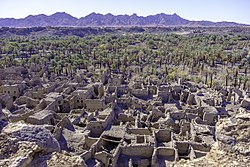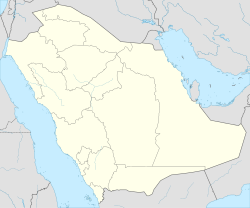Khaybar
Khaybar خَيْبَر | |
|---|---|
 Ancient ruins of Khaybar | |
| Coordinates: 25°41′55″N 39°17′33″E / 25.69861°N 39.29250°E | |
| Country | |
| Region | Al Madinah Region |
| established | 6th century BC |
| Time zone | UTC+3 (AST) |
Khaybar[note 1] (Arabic: خَيْبَر, IPA: [ˈxajbar]) is an oasis in Medina Province, Saudi Arabia, situated some 153 kilometres (95 mi) north of the city of Medina. Prior to the arrival of Islam in the 7th century, the area had been inhabited by a migrant Jewish tribes until the Battle of Khaybar when it was conquered by the Muslims in 628 CE.
History
Bronze Age
See the newly discovered archaelogical site of Al-Natah.
Pre-Islamic
Before the advent of Islam in the 7th century CE, indigenous Arabs and migrant Jews made up the population of Khaybar, but when Jewish settlement in northern Arabia began is unknown.[note 2] In 567, Khaybar was invaded and purged of its Jewish inhabitants by the Ghassanid Arab Christian king Al-Harith ibn Jabalah. He later freed the captives upon his return to the Levant. A brief account of the campaign is given by Ibn Qutaybah,[1] which may also be mentioned in the sixth-century Harran inscription.[2][3]
7th century
As late as the 7th century, Khaybar was still inhabited by Jews, who pioneered the cultivation of the oasis.[4]
Military campaigns of Muhammad
Expedition of Fadak
In 627, Muhammad ordered the Expedition of Fadak to attack the Bani Sa‘d bin Bakr tribe because Muhammad received intelligence they were planning to help the Jews of Khaybar.[5] In this expedition one person was captured by Muslims, and the rest of the tribe fled.[6]
Battle of Khaybar
The Battle of Khaybar took place in May/June 628.[7] The Jewish Banū Naḍīr of Medina, who claimed to be descendants of Aaron the priest, owned lands in Khaybar and had castles, fortresses and weapons there. After Muhammad expelled them from Medina in 625, their leaders moved to their estates in Khaybar to prepare for war against Muhammad and to recruit the aid of other non-Muslim Arab tribes. Muhammad first sent disguised guests to the homes of the leaders of Banū Naḍīr, who killed their hosts. Muhammad's victory over the Jews of Khaybar in the subsequent battle was also aided by the distance of the settlements and their castles from one another, the absence of co-ordination between the fighting forces, the death of the leader Sallām ibn Mishkam and a Jew who showed the Muslims the secret entrances to one of the fortresses. The castles of Khaybar had tunnels and passages, which in wartime enabled the besieged to reach water sources outside the castles.[8] Between 16 and 18 Muslims and 93 Jews were killed.[9]
Aftermath
Captives of war and slaves from other countries were brought to Khaybar, and the people of Hejaz became more accustomed to agriculture. Jews continued to live in the oasis for several years until they were finally expelled by Caliph Umar, who decided to expel the Jews of Khaybar in 642 under the pretense that before his death, Muhammad had commanded that two religions could not exist simultaneously in the Hejaz.[8]
Expulsion of Jews
During the reign of Caliph Umar (634–644), the Jewish community of Khaybar was transported alongside the Christian community of Najran to the newly-conquered regions of Syria and Iraq. Umar also forbade non-Muslims to reside in the Hejaz for longer than three days.[10] Since then, the Jews of Khaybar travelled around many areas throughout the Islamic Empire as artisans and merchants and they are still referred to in documents from the Middle Ages.[11]
Benjamin of Tudela
Benjamin of Tudela was a Jew from Tudela, in the Kingdom of Navarre, who travelled to Persia and Arabia in the 12th century. He visited and described Khaybar and neighboring Tayma sometime around 1170 and mentioned those places as Jewish habitations.[12]
Khaybar in culture and politics
Folklore
Khaybar is referred to in various traditions outside the Hejaz. The Makhamra family, a Palestinian extended family who lives in the city of Yatta, in the southern Hebron Hills, claims ancestry from the Jews of Khaybar. Over the years, there have been reports of locals in Yatta and its vicinity continuing to observe various Jewish rituals. In the late 19th century, peasants from Meithalun, present-day northern West Bank, associated a nearby ruin locally known as Khirbet Kheibar with an unnamed Jewish king and his daughter who, according to their tradition, resided in the area. Some scholars have suggested tying those two traditions to the expulsion of Jews from Khaybar and their settlement in the region.[13]
Contemporary antisemitic use
The tale of the Jews of Khaybar being vanquished and driven out has been revived in recent decades by the Palestinian Islamic militant group Hamas, who have used it as a political slogan in its propaganda against Israel.[13] The slogan has also been used by some at pro-Palestine protests and other anti-Israel events, as well as online.[14][15]
Economy
Historically, Khaybar is known for growing dates. The dates raised in the region were generally exported to Medina.[16]
Climate
| Climate data for Khaybar | |||||||||||||
|---|---|---|---|---|---|---|---|---|---|---|---|---|---|
| Month | Jan | Feb | Mar | Apr | May | Jun | Jul | Aug | Sep | Oct | Nov | Dec | Year |
| Mean daily maximum °C (°F) | 21.6 (70.9) |
24.6 (76.3) |
27.8 (82.0) |
32.6 (90.7) |
36.2 (97.2) |
38.9 (102.0) |
39.3 (102.7) |
39.3 (102.7) |
38.3 (100.9) |
34.2 (93.6) |
27.6 (81.7) |
22.8 (73.0) |
31.9 (89.5) |
| Mean daily minimum °C (°F) | 9.1 (48.4) |
7.6 (45.7) |
12.2 (54.0) |
16.0 (60.8) |
20.7 (69.3) |
24.0 (75.2) |
24.7 (76.5) |
24.8 (76.6) |
22.6 (72.7) |
18.4 (65.1) |
13.0 (55.4) |
9.0 (48.2) |
16.8 (62.3) |
| Average precipitation mm (inches) | 9 (0.4) |
3 (0.1) |
14 (0.6) |
12 (0.5) |
5 (0.2) |
0 (0) |
0 (0) |
1 (0.0) |
0 (0) |
4 (0.2) |
17 (0.7) |
8 (0.3) |
73 (2.9) |
| Source: Climate-data.org | |||||||||||||
See also
References
- ^ Other standardized Arabic transliterations: Ḫaybar / ḵaybar. Anglicized pronunciation: /ˈkaɪbər/, /ˈkaɪbɑːr/.
- ^ In a research conducted by David Samuel Margoliouth and published in the Journal of the Royal Asiatic Society in the last century, he points out the fact that the Jews of Khaybar and Yathrib (in Saudi Arabia), as early as the 6th century CE when Jews still lived there before they were evicted to places in Syria and to the city of Al-Kufah in Iraq, they did not differentiate between the non-accentuated "thau" (ת) and the accentuated "tau" (תּ) although both letters have distinct phonetic sounds by those scrupulous in the use of proper Hebrew grammar (See: Margoliouth, D.S.: "A poem attributed to Al-Samau’al." Journal of the Royal Asiatic Society. Published by the Society, 22, Albemarle St. London W. London, 1906. p. 364).
- ^ Ibn Qutaybah: al-Ma'arif
- ^ "Harran Inscription: A Pre-Islamic Arabic Inscription From 568 CE". islamic-awareness.org. Retrieved 2020-03-20.
- ^ Irfan Shahid: Byzantium and the Arabs in the sixth century, p. 322
- ^ Yāqut, Šihāb al-Dīn ibn ‘Abd Allah al-Ḥamawī al-Rūmī al-Baġdādī (ed. Ferdinand Wüstenfeld), Mu’jam al-Buldān, vol. IV, Leipzig 1866, p. 542 (reprint: Ṭaharān 1965, Maktabat al-Asadi); Hayyim Zeev Hirschberg, Israel Ba-‘Arav, Tel Aviv 1946, p. 343 (Hebrew).
- ^ Mubarakpuri, The Sealed Nectar, p. 211. (online)
- ^ Sa'd, Ibn (1967). Kitab al-tabaqat al-kabir, By Ibn Sa'd, Volume 2. Pakistan Historical Society. p. 110. ASIN B0007JAWMK.
SARIYYAH OF 'ALI IBN ABl TALIB AGAINST BANU SA'D IBN BAKR AT FADAK
- ^ Watt, W. Montgomery (1956). Muhammad at Medina. Oxford University Press. p. 2. ISBN 978-0195773071.
Muhammad had thus a straightforward reason for attacking Khaybar. The moment he chose for the attack May /June 628 (i/y) shortly after his return from the expedition of al-Hudaybiyah was one when it was also convenient for him to have booty to distribute to his followers whose expectations had recently been disappointed.
(free online) - ^ a b I. Ben-Ze'ev, Ha-Yehudim ba-Arav (19572), index; H.Z. Hirschberg, Yisrael ba-Arav (1946), index; I. Ben Zvi, in: Keneset, 5 (1940), 281–302; J. Braslavsky, Le-Ḥeker Arẓenu (1954), 3–52 (English summaries: 3–4, English section); S.D. Goitein, in: KS, 9 (1932/33), 507–21; Caetani, in: Annali dell' Islam, 2 (1905), 8–41; R. Leszynsky, Juden in Arabien zur Zeit Mohammeds (1910)
- ^ Mubarakpuri, The Sealed Nectar, p. 238. (online)
- ^ Giorgio Levi Della Vida and Michael Bonner, Encyclopaedia of Islam, and Madelung, The Succession to Prophet Muhammad, p. 74
- ^ Lowin, Shari (2010-10-01), "Khaybar", Encyclopedia of Jews in the Islamic World, Brill, pp. 148–150, doi:10.1163/1878-9781_ejiw_com_0012910, retrieved 2023-06-22
- ^ The Itinerary of Benjamin of Tudela (ed. Marcus Nathan Adler), Oxford University Press, London 1907, pp. 47-49.
- ^ a b Lowin, Shari (2010-10-01), "Khaybar", Encyclopedia of Jews in the Islamic World, Brill, pp. 148–150, doi:10.1163/1878-9781_ejiw_com_0012910, retrieved 2023-06-22
- ^ "Death threat to Jews sung openly at rallies across the UK". The Jewish Chronicle. 21 April 2022. Retrieved 2023-11-19.
- ^ "Antisemitism online directly increases real-world violence, study finds". The Jerusalem Post. 2023-11-18. Retrieved 2023-11-19.
- ^ Prothero, G. W. (1920). Arabia. London: H.M. Stationery Office. p. 83.
External links
- Joseph Braslavi (Braslavski) and Leah Bornstein-Makovetsky (1972, 2006), Khaybar, in Encyclopedia Judaica, via Jewish Virtual Library

